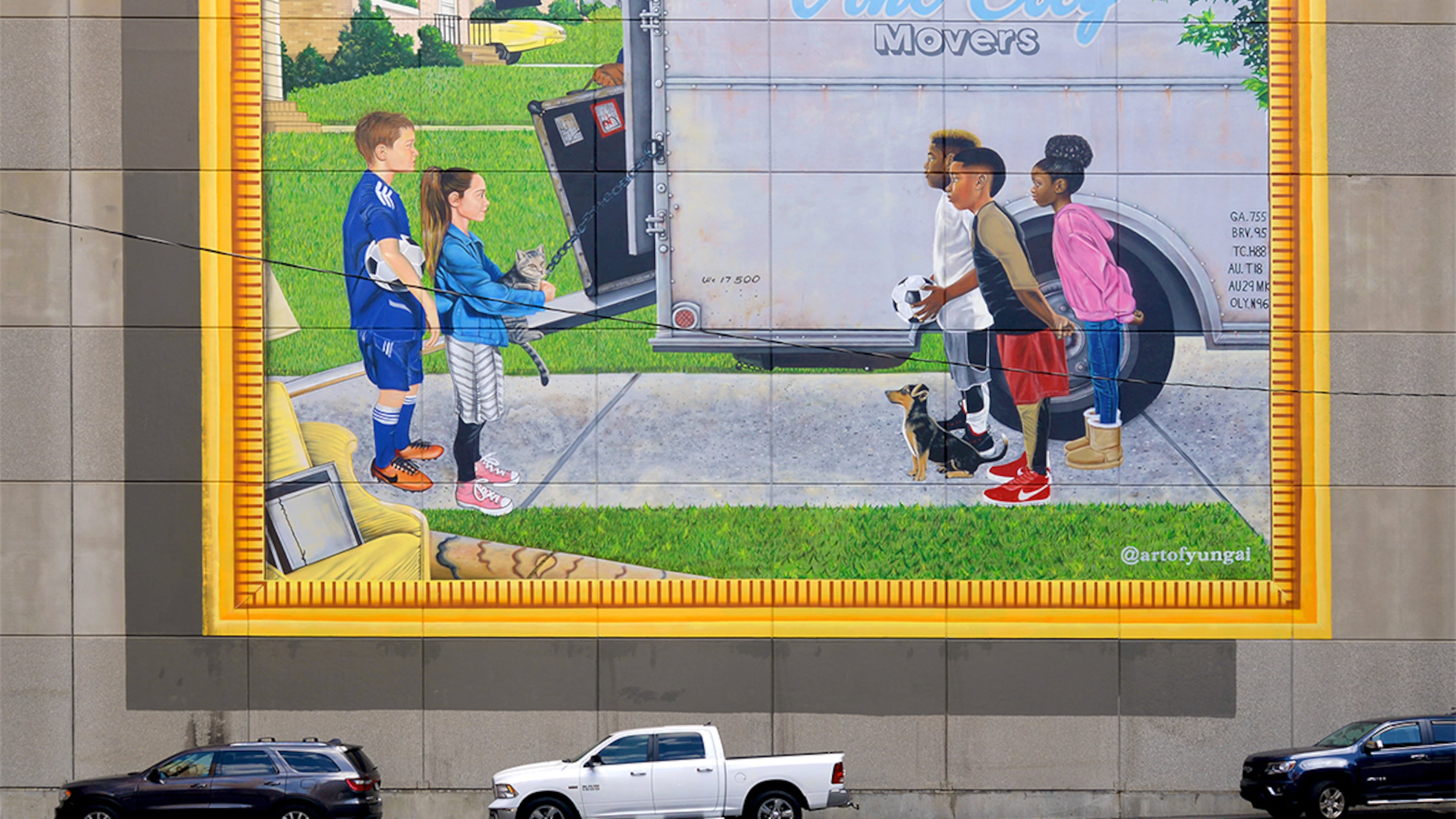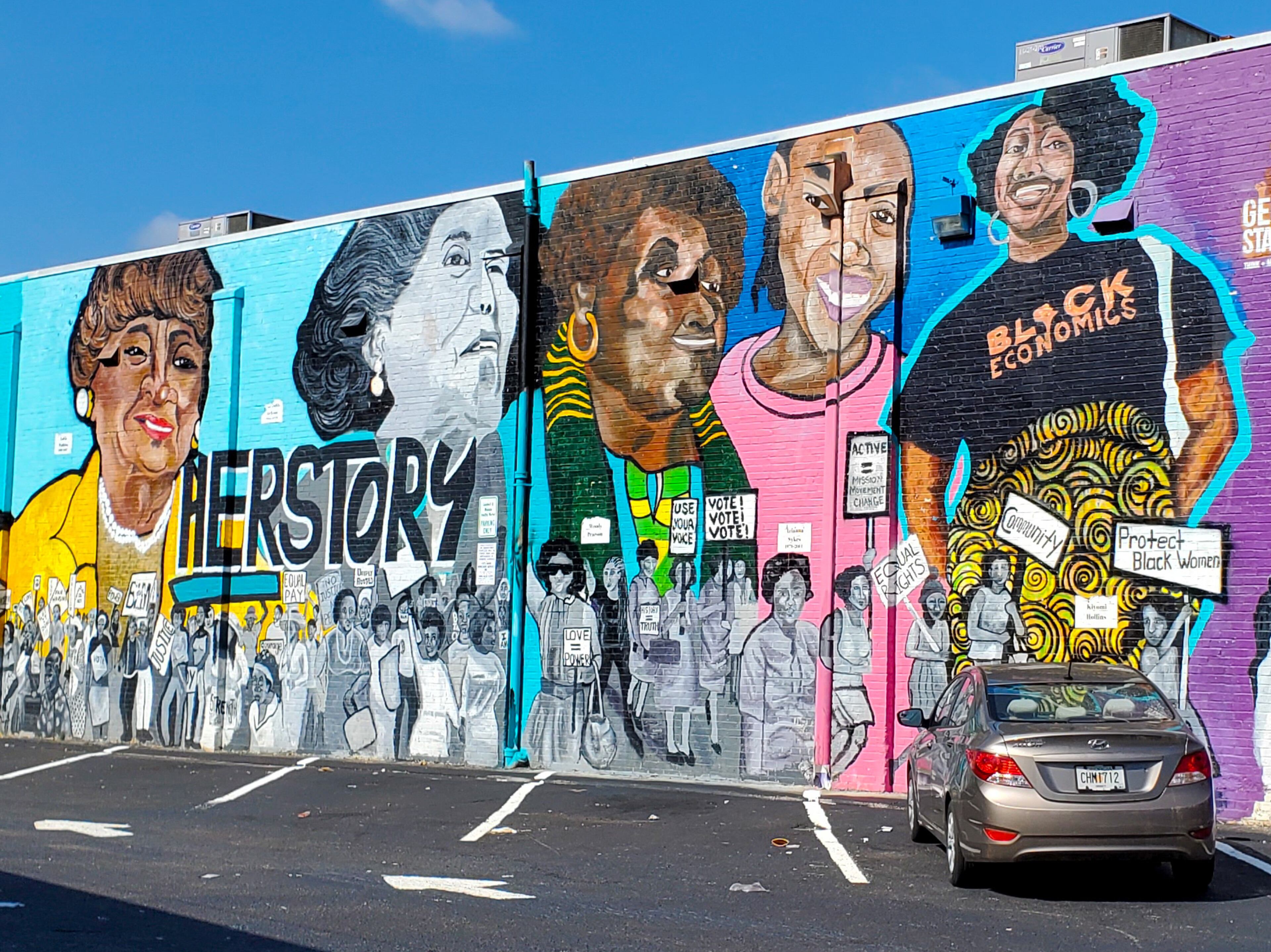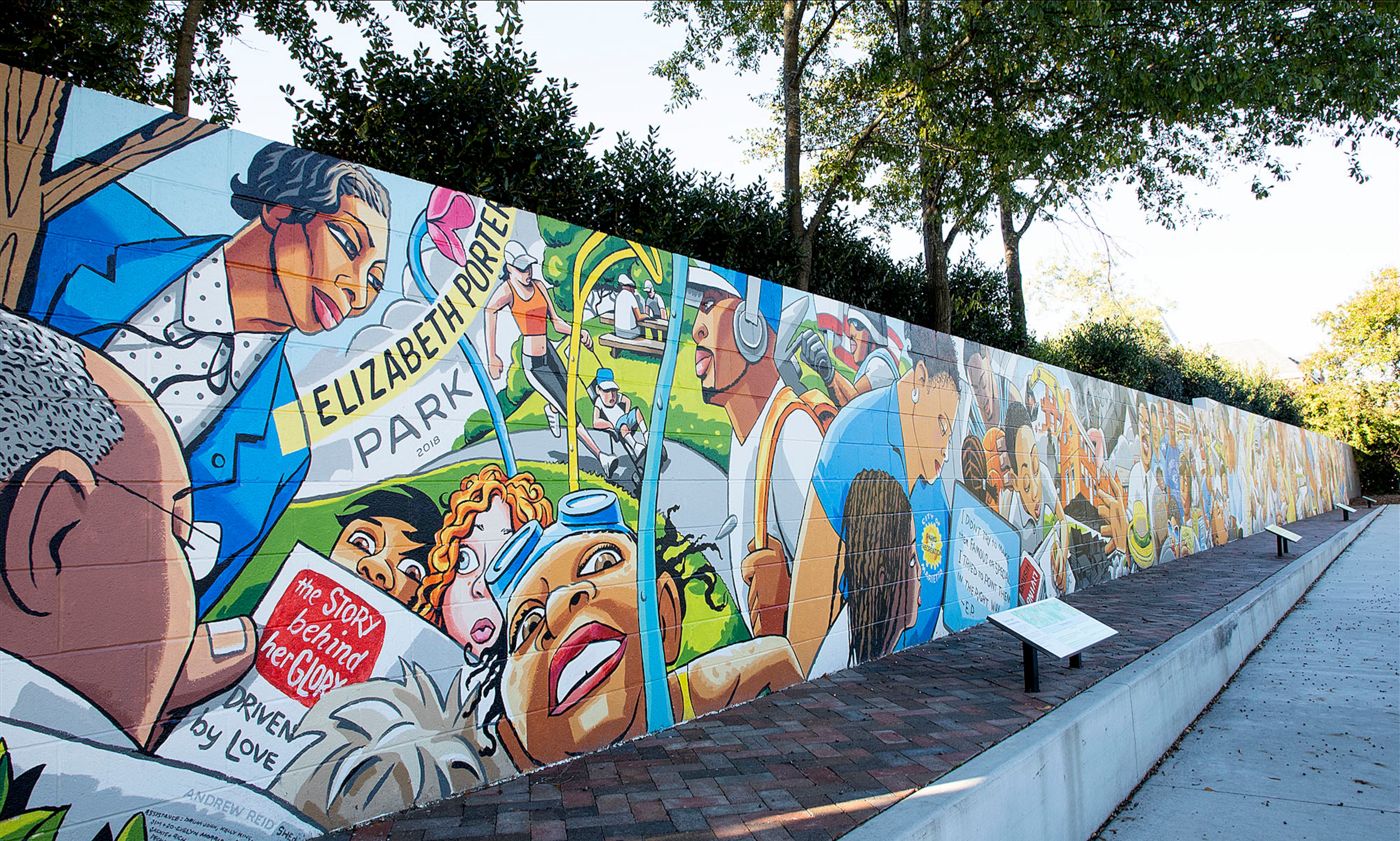10 Atlanta murals that celebrate Black history, identity and resistance

From MARTA stations to Morehouse walls, Atlanta is a living gallery of works created by and for the Black community that speak to Black pride, pain, joy, and resilience. These murals aren’t just pretty backdrops for selfies. They function as sites of memory, protest, and cultural preservation, marking struggles, honoring ancestors, and pushing conversations forward.
What follows is a curated list of 10 metro Atlanta murals illuminating Black life’s richness and resilience. Together, they offer a map — not just of geography, but of meaning, struggle, and hope. Atlanta’s walls aren’t just decorated — they’re defined by these voices, visions, and truths. And as the artists keep painting, the city keeps remembering.
HERstory: Heroines of the West End by Ashley Dopson

888 Ralph David Abernathy Boulevard, Atlanta
Ashley Dopson’s “HERstory” is a powerful tribute to the women who shaped Atlanta’s West End — a part of the city often left out of mainstream narratives. Dopson, an arts educator with Atlanta Public Schools, views the work as more than art: “It reminds us who we are, and we need to be reminded every day,” she says. Featuring local figures such as longtime Atlanta City Councilmember Cleta Winslow, Gangstas to Growers founder Abiodun Henderson, writer Pearl Cleage, and real-estate entrepreneur Lottie Watkins, among others, this wall is equal parts history lesson and healing space.
Rise Above by Fahamu Pecou

377 Decatur Street SE, Atlanta (King Memorial MARTA Station)
Set against the backdrop of a city central to the Civil Rights Movement, Fahamu Pecou’s RISE ABOVErefuses to rest on past victories. The work is inspired by a lesser-known Dr. Martin Luther King quote about rising above individual concerns for the greater good. “It’s on us to carry the movement forward,” Pecou says. This mural is a call to action, urging Atlanta to keep pushing.
Dreaming of Freedom by Sachi Rome
Wylie Street, Cabbagetown, Atlanta
Originally paintedin 2019 and updated in 2022, “Dreaming of Freedom” features the line, “Freedom for my ancestors, freedom for she and he, peace for them. Peace for me. I want to be free without having to get angel wings.” It’s a message both personal and collective for its creator, Sachi Rome. “It reflects the constant dream of true freedom that we all deserve,” Rome says.
Black to the Future by Fabian Williams
Morehouse College, Atlanta
Fabian Williams calls “Black to the Future” his thesis on muralism. It’s a sweeping, 300-foot-long visual timeline starting in ancient Ethiopia and ending with a speculative future placing Morehouse on another planet. “Since history is being removed from libraries, my goal was to put history on the wall,” Williams says. Designed to inspire students and inform communities, it’s both educational and deeply imaginative.
Brian aka Black Lives Matter by Joe King
Wylie Street, Cabbagetown, Atlanta
Joe King’s mural began in 2014 as a portrait of a man he met at a gas station. It wasn’t until 2020, after the murder of George Floyd, that he added the now-famous words: “Black Lives Matter.” The mural became a community focal point, updated with messages like “VOTE” during the 2020 Senate runoff. It’s one of the oldest murals in Cabbagetown and still sparks conversation. “It evoked the idea of the disenfranchised Black community holding Atlanta accountable,” King says.
New Kids on the Block by Muhammad Yungai
Luckie and Forsyth Streets, Atlanta
Muhammad Yungai’s Vine City mural is a remix of Norman Rockwell’s “New Kids in the Neighborhood,” reimagined in the context of gentrification. Yungai shows Black children watching a white family move in, and leaves the adults out on purpose. It’s subtle and provocative. “The mural doesn’t vilify the new family, but centers the Black community’s perspective,” Yungai says. Atlanta Falcons flags, soccer balls, cats, and dogs all contribute to a layered narrative. It’s a quiet but powerful lens on a rapidly changing city.
Time for Change by Tommy Bronx and Ash ‘Wolfdog’ Hayner
Irwin and Randolph Streets, Atlanta
Created during the height of the 2020 Black Lives Matter protests, “Time for Change” is as urgent as the moment it emerged from. Commissioned by ABV Gallery, the mural calls on passersby to reflect, remember, and respond. Artist Tommy Bronx describes it as “a visual outcry for justice, a call to break cycles of hate, systemic violence, and silence.” Bold and unflinching, the piece is a street-level marker of Atlanta’s ongoing fight for equity. “To me it’s not just a mural,” Bronx says. “It’s a promise to stay awake, speak out, and demand transformation.”
Kin by Neka King
Path400, Atlanta
Painted in 2019 as part of ABV Gallery’s OuterSpace mural festival, “Kin” is one of artist Neka King’s earliest public-facing works. Set beside a patch of grass along Path400 in Buckhead, the mural honors both Black familial bonds and a deeper connection to the land itself. “I immediately connected with the patch of grass that the mural rests upon,” King says. “I thought about how Black folk have been in connection with this land for a long time... I wanted to make them visible while honoring the continued connection we still share.” Joyful but intentional, the mural weaves ancestry, presence, and place into a vibrant visual statement about belonging.
Baptist Town by Andrew Reid

370 Montgomery St, Marietta
Spanning 130 feet along Elizabeth Porter Park, “Baptist Town” is a sweeping visual tribute to one of Marietta’s oldest historically Black neighborhoods. Commissioned by the Marietta Arts Council and completed in 2019, the mural resulted from a two-year collaboration between artist Andrew Reid and a local committee. Reid was selected from a pool of 30 national artists and immersed himself in the community’s history, drawing from personal stories and archival research to inform the work. Through vivid imagery, it preserves the neighborhood’s rich heritage and serves as a lasting testament to the contributions of Marietta’s African American community.
Flowers Divine: Honoring Marjorie Prothro by Charmaine Minniefield
3468 N. Fulton Avenue, Hapeville
Charmaine Minniefield’s “Flowers Divine” is a vibrant tribute to Marjorie Prothro, Hapeville’s first African American business owner. Commissioned by the city in 2018, the mural covers the side of Hapeville City Hall, facing Arts Alley. Prothro, a pioneering florist, opened her shop at 587 North Central Avenue, breaking racial barriers in the community. “Flowers Divine” not only commemorates Prothro’s achievements but also reinforces the importance of recognizing and celebrating the contributions of Black women in shaping local histories. The mural is a lasting legacy, grounding community pride in its rich heritage.
404WARD: A CONVERSATION
Atlanta’s vibrant Black community is known for moving the culture forward through visionary thinking, strategic action, tireless advocacy and positive leadership.404ward, a new signature series from UATL, recognizes these individuals each month, with feature stories highlighting their impact and why they matter to the city. More than a series, 404ward is a conversation. Join us on social — @itsuatl — or send an email to uatl@ajc.com to let us know what you think. You can also submit nominations for others making a difference and making Atlanta the capital of Black culture in America. Visit AJC.com/404ward or the AJC News app for more information.
Become a member of UATL for more stories like this in our newsletter and other membership benefits.
Follow UATL on Facebook, on X, TikTok and Instagram.